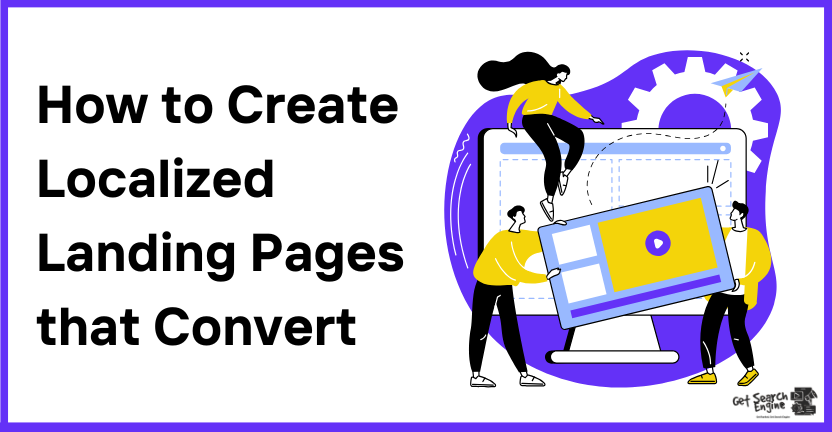Localized landing pages are specialized web pages designed to capture audiences’ attention within specific geographic areas. Unlike general landing pages, these pages focus on delivering targeted content that speaks directly to the needs and preferences of local customers. They are vital in helping businesses establish a strong regional presence and drive meaningful engagement.
Why Localized Landing Pages Matter:
- Increased Visibility: Localized pages rank higher in location-specific searches, such as “plumber near me” or “best coffee shop in [city].”
- Improved Conversions: These pages personalise the experience by addressing local customer needs, increasing the likelihood of conversions.
- Stronger Local Branding: Tailored content fosters trust and strengthens connections with the local community.
This blog will explore the key strategies and best practices to create effective localised landing pages, helping businesses attract, engage, and convert local audiences into loyal customers.
What Are Localized Landing Pages?
Localised landing pages are dedicated web pages tailored to attract and engage audiences in specific geographic areas. Unlike generic landing pages that cater to a broad audience, localised pages are crafted with content, keywords, and visuals that resonate with a particular location. These pages are essential for businesses aiming to establish a strong presence in local markets and attract nearby customers.
Purpose of Localized Landing Pages:
- Target Local Audiences: These pages focus on connecting with customers searching for services in a specific area.
- Enhance User Experience: Businesses can create a sense of trust and relevance by incorporating familiar imagery, maps, or local testimonials.
- Boost Local SEO Rankings: Including location-specific keywords helps improve visibility in local search results.
Key Features of Localized Landing Pages:
- Localised Keywords: Use terms like “Best Bakery in Brooklyn” or “Plumbing Services in Chicago.”
- Location-Specific Content: Highlight services, offers, or benefits unique to the targeted area.
- Interactive Elements: Incorporate maps, directions, and local reviews to provide value and build trust.
By creating localised landing pages, businesses can better align with their audience’s needs, leading to higher engagement and improved conversion rates.
Why Do Localized Landing Pages Matter?
Localised landing pages are crucial for businesses that attract customers in specific geographic areas. By tailoring content to meet the needs of local audiences, these pages create a more personalised experience, which can significantly improve engagement and conversions.
Benefits of Localized Landing Pages:
- Improved Local SEO:
- Localised landing pages incorporate location-based keywords (e.g., “best coffee shop in Denver”), improving visibility in search results.
- Higher rankings in local searches increase the likelihood of attracting nearby customers.
- Higher Conversion Rates:
- Personalisation resonates with local audiences, making them more likely to trust your business and take action.
- Highlighting services or offers specific to a location encourages quick decision-making.
- Stronger Customer Engagement:
- Addressing local preferences builds trust and fosters loyalty.
- Including local testimonials, neighbourhood maps, and region-specific imagery connects your business with the community.
For instance, a local cleaning service that mentions same-day cleaning availability in [City] on its landing page is more likely to convert visitors into customers. Localised landing pages are not just a tool for visibility—they create meaningful connections that drive long-term growth.
Key Elements of a High-Converting Localized Landing Page
Businesses must focus on several essential elements to create a localised landing page that captures attention and drives conversions. These components enhance user experience and improve local SEO and lead generation.
Essential Elements of a Localized Landing Page:
- Localised Keywords:
- Use keywords that reflect the target location, such as “Best Home Cleaning Services in San Diego.”
- Include these keywords in the page title, headers, and meta descriptions to boost local search rankings.
- Clear Call-to-Action (CTA):
- A strong, actionable CTA guides visitors toward the desired action. Examples include:
- “Schedule Your Free Consultation in [City]!”
- “Call [Local Number] for Expert Services Today.”
- A strong, actionable CTA guides visitors toward the desired action. Examples include:
- Location-Specific Content:
- Mention local landmarks, events, or community aspects to create a personal connection with the audience.
- For example, a café in Austin could highlight its proximity to popular local spots like Zilker Park.
- Mobile Optimization:
- Ensure the landing page is responsive and loads quickly on mobile devices.
- Mobile-friendly pages are critical, as many local searches occur on smartphones.
- Contact Information:
- Prominently display the local address, phone number, and an embedded map for easy navigation.
- Include a contact form tailored for local inquiries.
- Trust Signals:
- Add customer testimonials from the local community, certifications, or awards to build credibility.
- Showcase Google reviews or case studies specific to the region.
By integrating these elements, businesses can design localised landing pages that resonate with their audience, improve engagement, and drive higher conversion rates.
Steps to Create Localized Landing Pages
Creating effective localised landing pages requires a structured approach. These steps will help you design and optimise pages that connect with your audience and drive conversions.
- Start by identifying keywords that reflect the services or products your target audience is searching for in your area.
- Use tools like Google Keyword Planner or SEMrush to find phrases like “Best HVAC Services in [City]” or “Top Lawyers in [Neighborhood].”
2. Customize Content for the Area:
- Write content that addresses the specific needs or preferences of the local audience.
- Mention local events, landmarks, or cultural details to make the page relatable.
3. Include Maps and Directions:
- Embed a Google Map on the page to help customers find your business location quickly.
- Provide clear directions or links to navigation apps for added convenience.
- Highlight feedback or reviews from customers in the same region.
- Testimonials build trust and show that your business is well-regarded in the area.
- Conduct A/B testing to refine page elements like headlines, calls-to-action (CTAs), and images.
- Use analytics tools to track performance and make data-driven adjustments.
Following these steps, businesses can create localised landing pages that attract local visitors and convert them into loyal customers. This approach ensures a strong connection with the community and maximises the impact of their online presence.
Common Mistakes to Avoid
Creating localised landing pages requires precision and attention to detail. However, several common mistakes can undermine their effectiveness and reduce their impact.
Avoid These Common Mistakes:
- Inconsistent Information:
- Ensure that your business name, address, phone number (NAP), and other details are accurate and consistent across all platforms. Discrepancies can confuse customers and search engines, negatively affecting your local SEO.
- Generic Content:
- Avoid using vague or generic content that fails to address your local audience’s specific needs and interests. Personalised content with local references fosters trust and engagement.
- Ignoring Mobile Users:
- Many local searches are conducted on mobile devices. A non-responsive or slow-loading design can frustrate users and drive them away. Ensure your page is mobile-friendly and optimised for a seamless experience.
By avoiding these pitfalls, businesses can create localised landing pages that engage visitors, provide valuable information, and drive higher conversion rates. A well-executed landing page aligns with local customers’ expectations and supports business growth.
Conclusion
Localised landing pages are a powerful way for businesses to connect with their community and convert local visitors into loyal customers. By using location-based keywords, personalising content, and ensuring mobile optimisation, these pages enhance visibility and foster trust among potential customers.
Key Takeaways:
- Incorporate local keywords and references.
- Focus on mobile-friendly design for seamless user experiences.
- Build trust with localised testimonials and accurate contact information.
Start implementing these best practices today to attract more local customers and strengthen your business’s presence in your community.






Leave a Reply